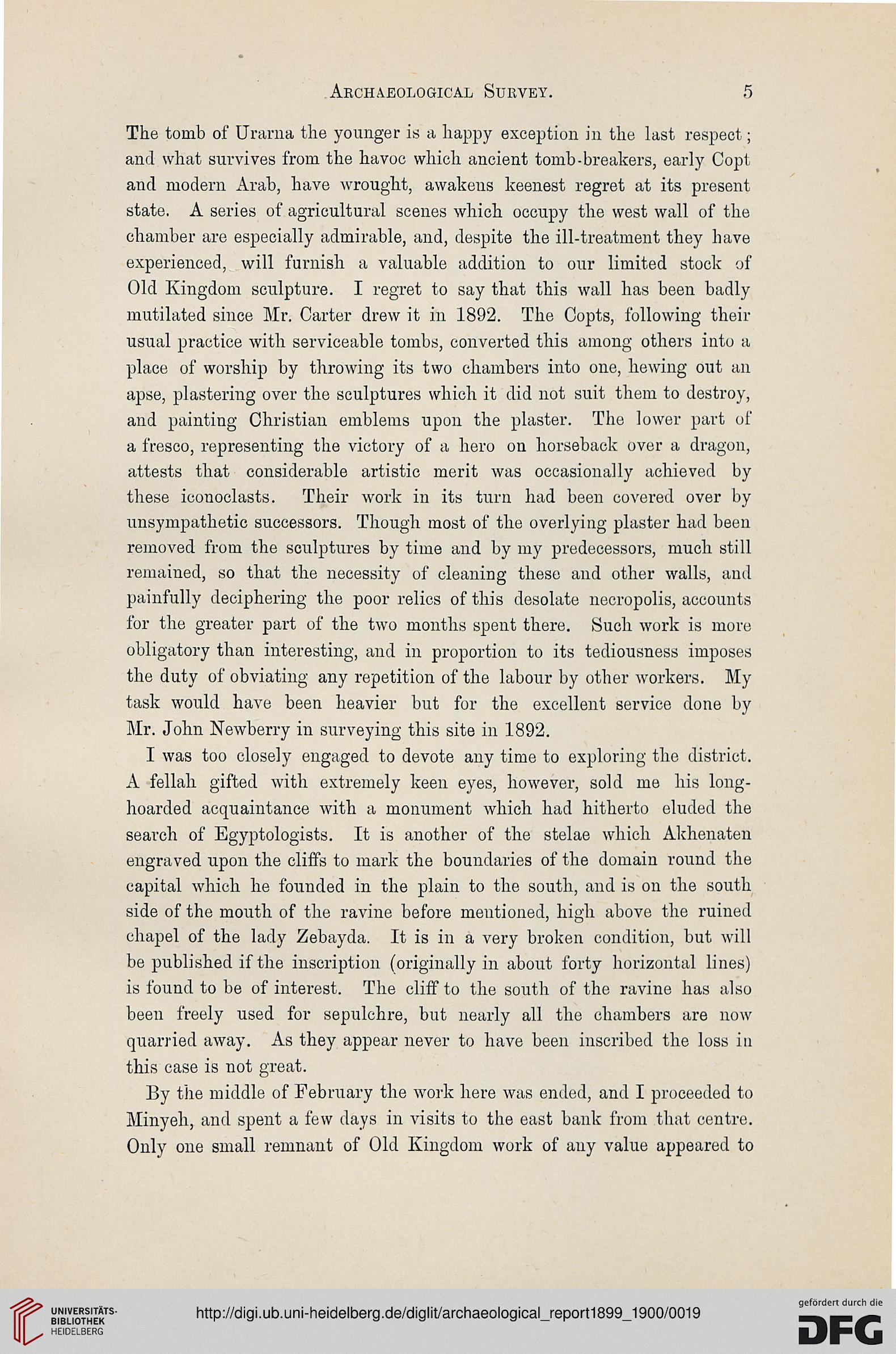Archaeological Survey.
5
The tomb of Urania the younger is a happy exception in the last respect;
and what survives from the havoc which ancient tomb-breakers, early Copt
and modern Arab, have wrought, awakens keenest regret at its present
state. A series of agricultural scenes which occupy the west wall of the
chamber are especially admirable, and, despite the ill-treatment they have
experienced, will furnish a valuable addition to our limited stock of
Old Kingdom sculpture. I regret to say that this wall has been badly
mutilated since Mr. Carter drew it in 1892. The Copts, following then-
usual practice with serviceable tombs, converted this among others into a
place of worship by throwing its two chambers into one, hewing out an
apse, plastering over the sculptures which it did not suit them to destroy,
and painting Christian emblems upon the plaster. The lower part of
a fresco, representing the victory of a hero on horseback over a dragon,
attests that considerable artistic merit was occasionally achieved by
these iconoclasts. Their work in its turn had been covered over by
unsympathetic successors. Though most of the overlying plaster had been
removed from the sculptures by time and by my predecessors, much still
remained, so that the necessity of cleaning these and other walls, and
painfully deciphering the poor relics of this desolate necropolis, accounts
for the greater part of the two months spent there. Such work is more
obligatory than interesting, and in proportion to its tediousness imposes
the duty of obviating any repetition of the labour by other workers. My
task would have been heavier but for the excellent service done by
Mr. John Newberry in surveying this site in 1892.
I was too closely engaged to devote any time to exploring the district.
A fellah gifted with extremely keen eyes, however, sold me his long-
hoarded acquaintance with a monument which had hitherto eluded the
search of Egyptologists. It is another of the stelae which Akhenaten
engraved upon the cliffs to mark the boundaries of the domain round the
capital which he founded in the plain to the south, and is on the south
side of the mouth of the ravine before mentioned, high above the ruined
chapel of the lady Zebayda. It is in a very broken condition, but will
be published if the inscription (originally in about forty horizontal lines)
is found to be of interest. The cliff to the south of the ravine has also
been freely used for sepulchre, but nearly all the chambers are now
quarried away. As they appear never to have been inscribed the loss in
this case is not great.
By the middle of February the work here was ended, and I proceeded to
Minyeh, and spent a few days in visits to the east bank from that centre.
Only one small remnant of Old Kingdom work of any value appeared to
5
The tomb of Urania the younger is a happy exception in the last respect;
and what survives from the havoc which ancient tomb-breakers, early Copt
and modern Arab, have wrought, awakens keenest regret at its present
state. A series of agricultural scenes which occupy the west wall of the
chamber are especially admirable, and, despite the ill-treatment they have
experienced, will furnish a valuable addition to our limited stock of
Old Kingdom sculpture. I regret to say that this wall has been badly
mutilated since Mr. Carter drew it in 1892. The Copts, following then-
usual practice with serviceable tombs, converted this among others into a
place of worship by throwing its two chambers into one, hewing out an
apse, plastering over the sculptures which it did not suit them to destroy,
and painting Christian emblems upon the plaster. The lower part of
a fresco, representing the victory of a hero on horseback over a dragon,
attests that considerable artistic merit was occasionally achieved by
these iconoclasts. Their work in its turn had been covered over by
unsympathetic successors. Though most of the overlying plaster had been
removed from the sculptures by time and by my predecessors, much still
remained, so that the necessity of cleaning these and other walls, and
painfully deciphering the poor relics of this desolate necropolis, accounts
for the greater part of the two months spent there. Such work is more
obligatory than interesting, and in proportion to its tediousness imposes
the duty of obviating any repetition of the labour by other workers. My
task would have been heavier but for the excellent service done by
Mr. John Newberry in surveying this site in 1892.
I was too closely engaged to devote any time to exploring the district.
A fellah gifted with extremely keen eyes, however, sold me his long-
hoarded acquaintance with a monument which had hitherto eluded the
search of Egyptologists. It is another of the stelae which Akhenaten
engraved upon the cliffs to mark the boundaries of the domain round the
capital which he founded in the plain to the south, and is on the south
side of the mouth of the ravine before mentioned, high above the ruined
chapel of the lady Zebayda. It is in a very broken condition, but will
be published if the inscription (originally in about forty horizontal lines)
is found to be of interest. The cliff to the south of the ravine has also
been freely used for sepulchre, but nearly all the chambers are now
quarried away. As they appear never to have been inscribed the loss in
this case is not great.
By the middle of February the work here was ended, and I proceeded to
Minyeh, and spent a few days in visits to the east bank from that centre.
Only one small remnant of Old Kingdom work of any value appeared to





